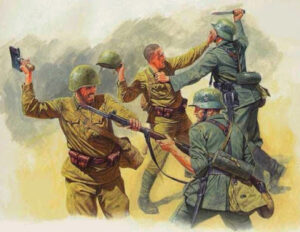During my recent researches of things Soviet I came across the following rather nice illustration. As is so often the case with these posts, another topic I had been reflecting upon had relevance here. This is not going to be a post on fighting with entrenching tools. There will be treatment of this topic in time, included a little known, possibly exclusive technique that most of you will not have encountered.


Those of you that have read my books will know that I advocate that you should have at least one weapon that can be accessed by your weaker hand. There are a number of scenarios wherein your stronger arm can get trapped, grabbed or wounded. In such a situation you should be able to use your other hand to bring a weapon into action. In the time of the Japanese samurai combats would often end in grappling, the winner being the one who could manoeuvre his opponent to a position from where he could insert a dagger trough a weak point in his opponent’s armour. Such grappling combats were actually fairly common in other cultures that used armour. I use Japan as an example since there are records that some samurai ensured that they wore a dagger on either side of the belt so that they could draw a weapon no matter which arm was entangled with an opponent.
As well as arming both sides, one should also be aware of the danger of having all you weapons on one level. I have been reading about some instances when police officers have been attacked with a tackling action. Since all of a cop’s authorized weapons are generally carried on his belt an attacker hugging him around the waist prevents him from drawing a weapon. The tackler does not need to be a skilled grappler to exploit this position. He can just hang on long enough for his friends to stomp the cop or steal his weapons and turn them against him.

Obviously, having weapons accessible at different levels is prudent. Many soldiers carry a knife on their webbing suspenders. I discuss this further in my second book as the “Pec Knife”. The positioning of such a knife allows it to be accessed with either hand even when one is down on the ground.
During the Second World War many soldiers and SOE agents carried small thumb knives or lapel knives. As the name suggests, these could be concealed behind a suit or uniform lapel. They were also hidden behind trouser braces, cap badges and a wide variety of other places. The lapel knife sheathes were provided with button holes so they could be attached to a button sewn wherever the user desired. At least one agent placed his knife in his inside pocket so he could draw it when asked for his papers.


Many readers will have heard of the “Sap Cap”, a baseball cap with a weight sewn in the back. Some of you will know that this commercial product is predated by “do it yourself” articles that suggest pinning a fishing weight in the back of a hat. The other day I came across a Russian source that advised soldiers to sew a piece of lead 30 x 20 x 1.5mm into the back of their uniform hats. This was a peaked “patrol hat” type item but I suspect that it would work with a beret too. Given that lead is toxic and can be absorbed through the skin I’d not use it in a hat unless it was well insulated. Steel shot, lead-free fishing weights and steel washers have been used instead. The piece of lead suggested above would have weighed less than a third of an ounce so a great weight or mass is probably not needed. As well as the obvious offensive use a sap-cap can be used to strike a hand holding a knife or thrown in the face to create a distraction.
The Soviet soldier using his helmet as a weapon obviously reminded me of the sap-cap idea. A helmet held in the hand also makes a pretty useful buckler against a knife or bayonet. As an aside, in his army days in Malaya my father sharpened the brim of his steel helmet.
If you are armed, you need weapons accessible by either hand. You also need plan for the situation that a weapon may not be accessible due to posture, body position or enemy action. And finally, you need to understand that if attacked there may not be time to draw a weapon. Often attempting to draw rather than initially countering an attack can be a fatal mistake. Your hands, boots and other body parts are the weapons you never have to waste time drawing. Learn how to use them well.